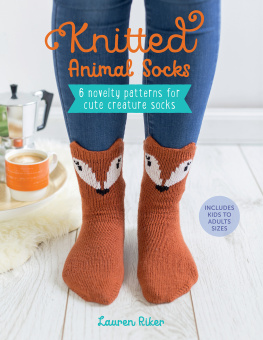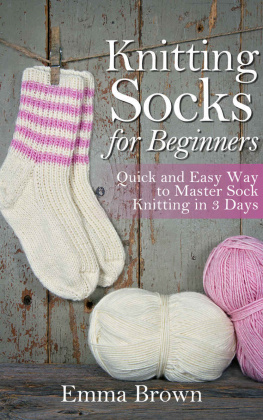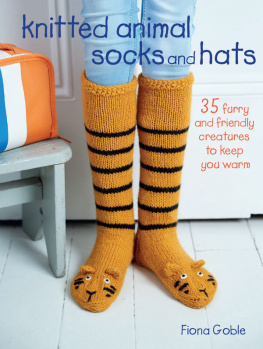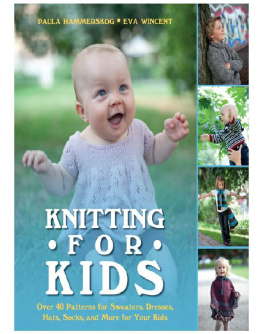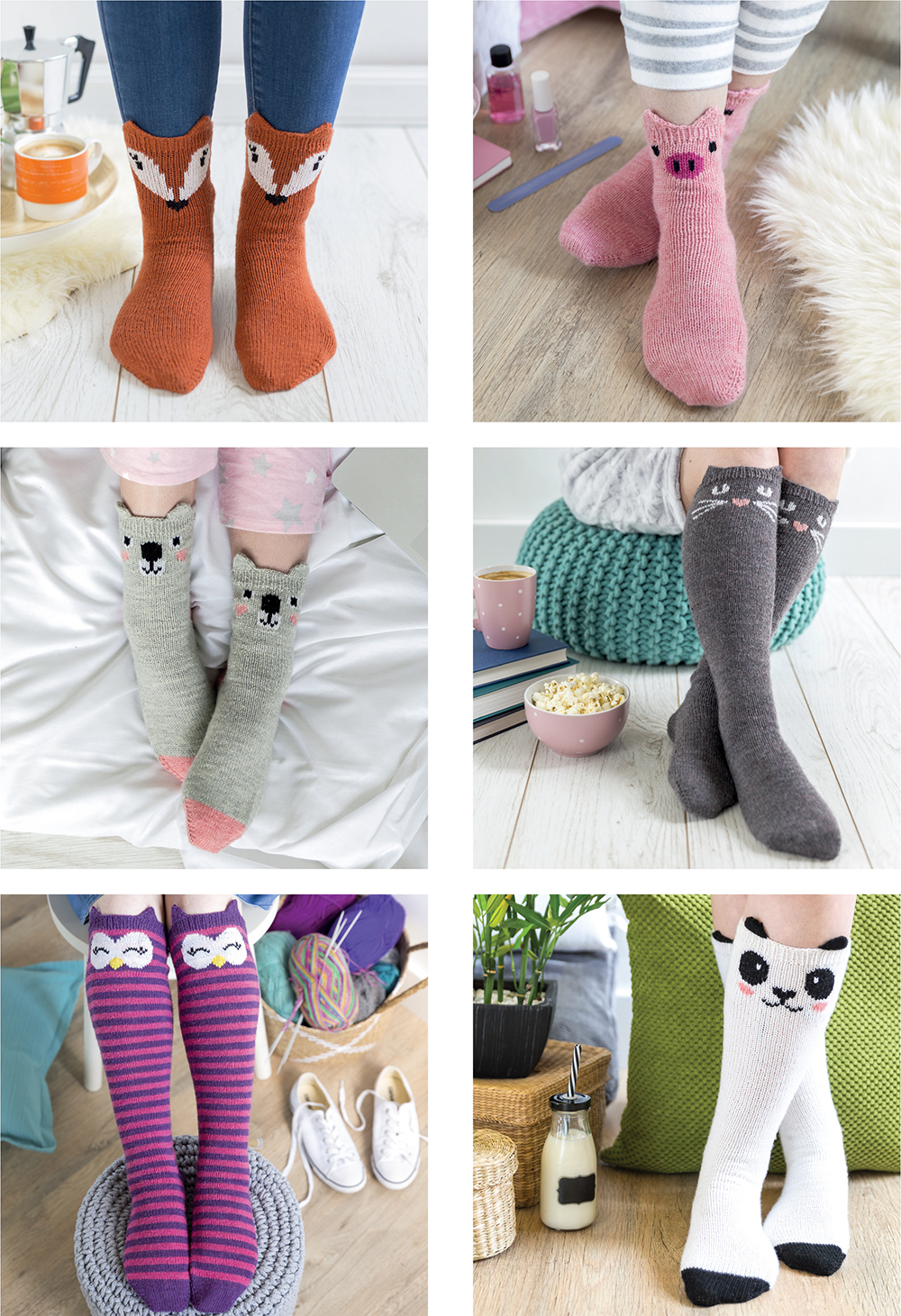Give your feet the ultimate treat with this collection of adorable knitted animal socks!
These colourful socks are guaranteed to brighten your day with their cute faces and adorable ears. Not only are these socks full of character from the front, but each animal design also features a fun message on the heel, making them extra special. When knitting your new pair of furry friends, you can also work a contrast toe, heel, or both, for added style.
Whether you choose to knit a pair of cat, owl, panda, koala, fox, or pig socks in ankle or knee-high length, you are sure to find an option that suits you and all of your loved ones.
You can have loads of fun playing around with alternative colourways and if youre feeling adventurous you could even design your own unique animal sock.
HOW TO USE THIS BOOK
Follow the steps below before you start knitting your socks.
Step 1 Read the Tools and Materials section, which specifies the type of yarn to use and the recommended needle sizes.
Step 2 Check your tension (gauge) following the instructions provided (see ) to make sure you are knitting to the required tension, otherwise your socks will not fit.
Step 3 Check the size chart (see ) and choose the correct size to knit.
Step 4 Read through the Techniques section to familiarise yourself with the basic stitches and techniques used (see ).
Step 5 Choose your project, and when finished, dont forget to block your socks (see Techniques: ).
TOOLS AND MATERIALS
YARN
4ply sock yarn is recommended as the best yarn to use. Sock yarn can also be classed as fingering weight and is generally a mix of wool and nylon, for flexibility and durability. You can choose sock yarn that is machine washable (labelled as superwash wool) or you can choose sock yarn that requires handwashing.
The yarn used for all of the socks in this book is Knit Picks Stroll Sock Yarn which is 75% superwash merino wool with 25% nylon. Each ball weighs 50g and is 211m/231yds in length. Quantities required for each pair of socks are specified within each pattern.
NEEDLES
For sock knitting, a set of 4 double-pointed needles (dpns) are recommended, in size 2.75mm (US 2) for the main sock (or size needed to achieve the correct tension), plus a set of size 2.25mm (US 1) dpns for the cuff and a single 3.75mm (US 5) needle for casting off loosely.
OTHER USEFUL EQUIPMENT
A pair of sharp scissors for snipping yarn.
A hard, see-through ruler for measuring tension.
A tape measure for measuring the length of longer pieces of knitting.
A wool/tapestry needle blunt ended (a pointy needle will split your yarn and spoil your knitting).
Sock blockers for blocking your socks.
Stitch markers to mark the start of the round (optional).
Stitch holder to hold stitches when not being worked on the needles.
Row counter helpful to keep a note of how many rows youve knitted.
Notebook and pen as an alternative to a row counter, or to make notes of your tension or any alterations or adaptations you make to a pattern.
Project bag perfect for keeping your work and equipment in.
TENSION
Before starting your socks you will need to knit up a tension (gauge) swatch. This is necessary so that your socks will fit snuggly and not end up either too big or too small.
Your knitted swatch will need to mirror the circular knitting of the socks and cannot be knitted flat as your tension will not be the same when knitting flat, compared to when knitting in the round. This is because when you work stocking stitch in the round, only knit stitches are used, whereas when you work stocking stitch flat, both knit and purl stitches are used. Tension can be different when knitting these two stitches, so they can be slightly different in size and they can also use different amounts of yarn.
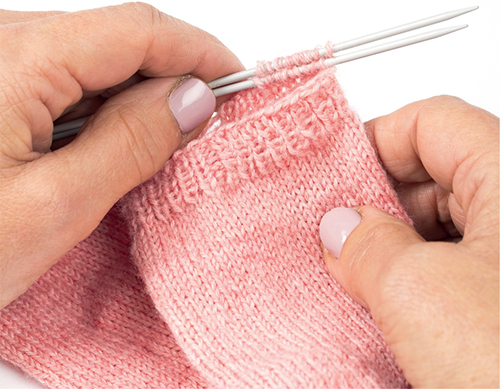
HOW TO MEASURE TENSION
Cast on the number of stitches that you need for your chosen sock size. Knit in the round for approximately 10cm (4in). Cast off. Lay your knitted tube on a flat surface. Place a see-through ruler vertically across the tube and measure how many stitches and rows there are to 2.5cm (1in).
For all socks in this book, tension should be:
7.75 sts and 10.5 rows to measure 2.5 x 2.5cm (1 x 1in) using 2.75mm needles over stocking stitch (worked in the round).
This equates to:
31 sts and 42 rows to measure 10 x 10cm (4 x 4in) using 2.75mm needles over stocking stitch (worked in the round).
If your stitch and row counts are the same as specified above, you can go ahead and start knitting. If you have more stitches and rows, you are knitting too tightly and your socks will end up too small. Youll need to make another swatch with slightly larger needles (and measure again).
If you have fewer stitches than specified, you are knitting too loosely and your socks will be too big. Youll need to make another swatch with slightly smaller needles and measure again.
Continue to swatch with different sized needles until you achieve the correct tension stated, and make sure that you always use this needle size for the main part of your socks.
Use the chart opposite to determine the most appropriate size to knit.
SIZE CHART
Ankle socks can be made in sizes XS:S:M:L:XL.
Long socks can be made in sizes S:M:L:XL.
Smallest size is written first with larger sizes in brackets, e.g. XS(S:M:L:XL).
Sock height is specified in each pattern.

ABBREVIATIONS
(see for detailed stitch instructions)
| dpn(s) | double-pointed needle(s) |
| k | knit |
| kfb | knit into the front and back of the next st (to increase 1 st) |
| k2tog | knit 2 sts together (to decrease 1 st) |
| p | purl |
| psso | pass slipped stitch over knitted stitch (to decrease 1 st) |
| rnd(s) | round(s) |
| sl | slip |
| ssk | slip next 2 sts, one at a time, to the right-hand needle then knit them both together through the back loops (to decrease 1 st) |
| st(s) | stitch(es) |
| W&T | wrap and turn |
Foxy Lady
ANKLE SOCKS
The fun starts here with these foxy socks! Full of personality, these cute creatures will delight anyone you knit them for. You can adapt the lettering to suit a child or a man, so you can make matching pairs for the whole family. Alternatively, why not substitute the orange shade for grey or even pale blue for a winter look?

